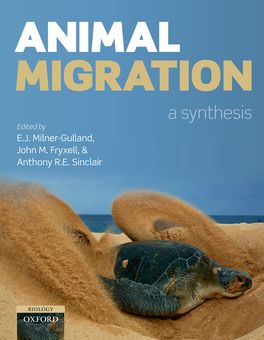Animal Migration

Animal Migration
|
ISBN: |
9780199568994 |
|
Binding: |
Hardback |
|
Published: |
20 Jan 2011 |
|
Availability: |
|
|
Series: |
$334.95 AUD
$377.99 NZD
Description
Contents
THEME 1: THE EVOLUTION OF MIGRATION
2: Kate Cresswell,Will Satterthwaite, and Greg Sword: Understanding the evolution of migration through empirical examples
3: Robert Holt and John Fryxell: Theoretical reflections on the evolution of migration
THEME 2: HOW TO MIGRATE
4: Anders Hedenström, Melissa Bowlin, Ran Nathan, Bart Nolet, and Martin Wikelski: Mechanistic principles of locomotion performance in migrating animals
5: Nir Sapir, Patrick J. Butler, Anders Hedenström, and Martin Wikelski: Energy gain and use during animal migration
6: Silke Bauer, Bart Nolet, Jarl Giske, Jason Chapman, Susanne Akesson, Anders Hedenström, and John Fryxell: Cues and Decision rules in animal migration
THEME 3: MIGRATION IN TIME AND SPACE
7: Niclas Jonzén, Endre Knudsen, Robert Holt, and Bernt-Erik Sæther: Uncertainty and predictability: the niches of migrants and nomads
8: Luca Börger, Jason Matthiopoulos, Ricardo Holdo, Juan Morales, Iain Couzin, and Edward McCauley: Migration quantified: Constructing models and linking them with data
THEME 4: BROADER CONTEXTS
9: Ricardo Holdo, Robert Holt, Anthony Sinclair, Brendan Godley, and Simon Thirgood: Migration impacts on communities and ecosystems: empirical evidence and theoretical insights
10: Roy Behnke, Maria Fernandez-Gimenez, Matthew Turner, and Florian Stammler: Pastoral migration: Mobile systems of animal husbandry
11: Jennifer Shuter, Annette Broderick, David Agnew, Niclas Jonzén, Brendan Godley, E.J. Milner-Gulland, and Simon Thirgood: Conservation and management of migratory species
12: E.J. Milner-Gulland, John Fryxell, and Anthony Sinclair: Conclusion
References
Index
Authors
Edited by E.J. Milner-Gulland , Imperial College London, UK
John M. Fryxell , University of Guelph, Canada
Anthony R.E. Sinclair , University of British Columbia, Canada
E.J. Milner-Gulland studied Pure and Applied Biology at Oxford University, and then did a PhD in resource management at Imperial College London, modelling the harvesting of elephants, rhinos and saiga antelopes. She held a Junior Research Fellowship at New College Oxford, was a visiting post-doctoral research at the University of British Columbia and then a Lecturer in Mathematical Ecology at the University of Warwick. After that she held a Lecturership in Resource Economics at Imperial College London, and became a Reader and then Professor in Conservation Science, also at Imperial College London. Her current research interests concern the interaction between human decision-making and the dynamics of exploited populations, as well as the ecology and conservation of the migratory saiga antelope in Central Asia. John Fryxell obtained both his undergraduate and graduate degrees from the University of British Columbia. His PhD research was on the ecology of the white-eared kob - a migratory antelope in the southern Sudan. He held a lectureship at the University of British Columbia and briefly worked with the Government of Newfoundland before assuming a faculty position at the University of Guelph, where he is currently a Professor in the Department of Integrative Biology. Anthony Sinclair has conducted research in Serengeti, Tanzania, since 1965, mainly on the problem of what determines the size of animal populations, particularly vertebrates, and the mechanisms of regulation. This work has expanded to look at the whole ecosystem, documenting how the different components of soils, plants, herbivores and predators interact. In particular, he is interested in how to provide scientific advice for conservation. In Canada he was part of the Kluane Boreal Forest Ecosystem project in the Yukon. This large-scale experiment examined the workings of the northern spruce forests, in particular what caused the 10-year cycle of snowshoe hare numbers. Between 1992 and 2002 Dr. Sinclair collaborated with colleagues in the CSIRO, Sustainable Ecosystems division, Commonwealth Government of Australia in experiments on the conservation of endangered marsupial prey and their exotic predators, the red fox and feral cats.